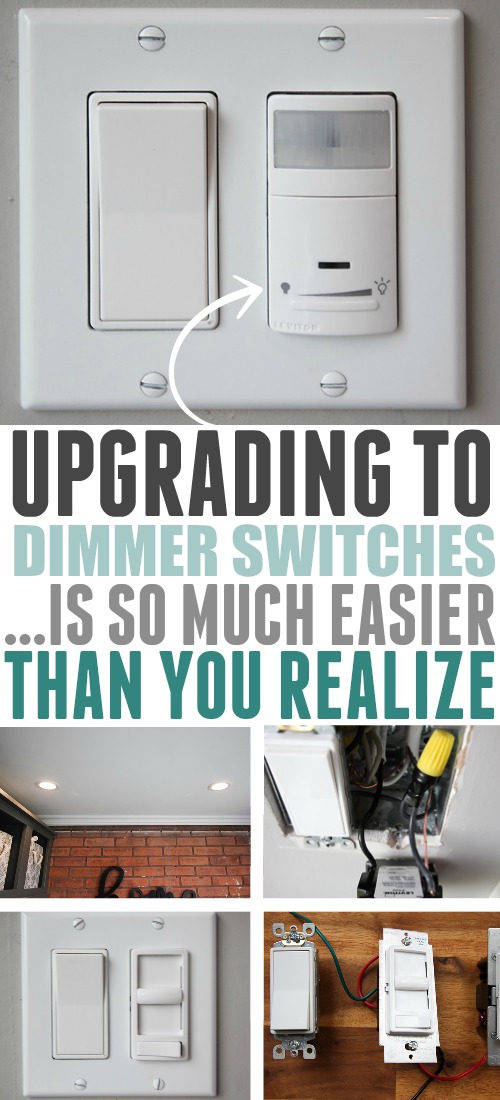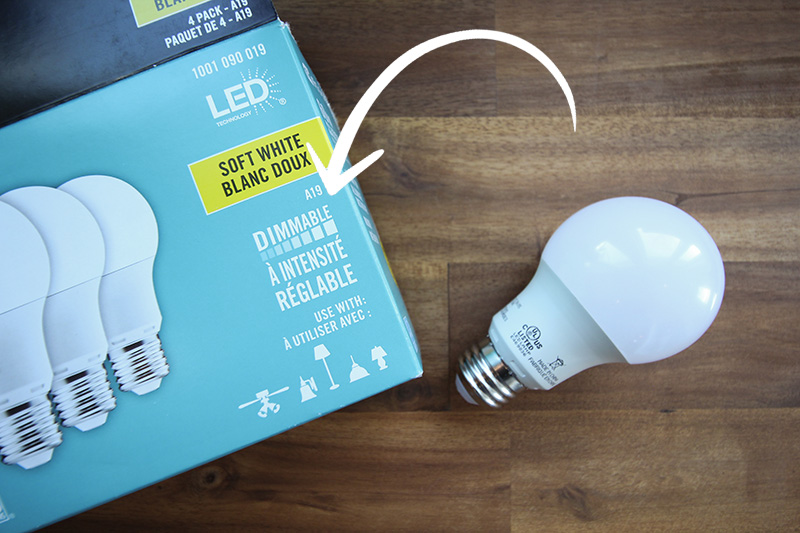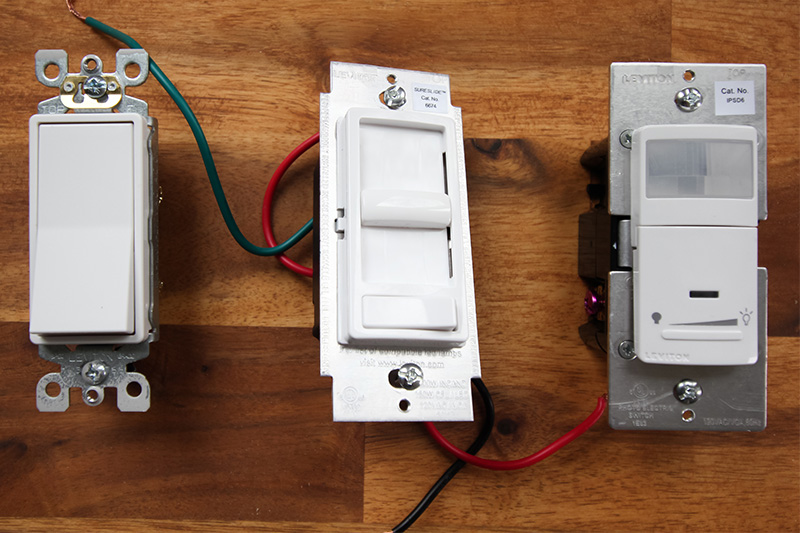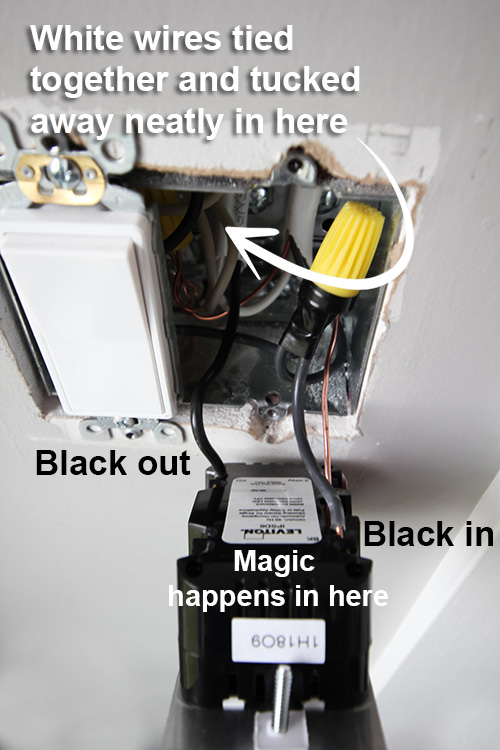Upgrading to dimmer switches is an easy DIY that can make a big difference in certain rooms of your home. Installing dimmer switches isn’t as complicated as it used to be!

I remember the dimmer switches from my childhood being kind of a really luxurious thing to have in your home. They were usually installed in the dining rooms of fancy homes, and weren’t just for any ol’ space. They were also a bit complicated to use because only certain types of light bulbs were dimmable. I think for some of us that were around back then, dimmer switches still seem like something that might be kind of a nuisance to deal with in our homes, unless it’s somewhere that we really really need them and are willing to go to the extra effort for. The great news is that installing dimmer switches these days is really no big deal, and it’s a great solution for so many different rooms and situations.
Where to Use Dimmer Switches in Your Home
Chris was recently inspired to go around our house and upgrade a few different light switches around our home. I have to say that I wasn’t as enthusiastic about it as I could have been. In my mind, I was still thinking that it seemed like an awful lot of work when I really had no complaints about our current lighting situation.
Actually I’ve been pretty ecstatic about the lighting situation in our mudroom. We have two porch lights just outside now and we have beautiful, bright pot lights inside. The lighting in the older parts of our home was definitely lacking when we moved in and it’s always so exciting when we add in new lighting somewhere. The problem was that the mudroom was a little too bright, especially at night. Since the front wall of our mudroom is all windows, it made us feel a little like we were on a stage for the whole world to see whenever we turned the lights on in there.
Chris also wanted to install a dimmer in our front hall because we leave that light on all night so we can all go up and down the stairs if needed. I’m thinking this might also be a great option for our upstairs hall light too because we don’t have anywhere to plug in a nightlight. Dimmers allow you to create really soft light using your existing light fixtures.
And of course now we’re thinking the new chandelier that we installed in the dinning room could definitely use a dimmer too. 🙂
What Kind of Light Bulbs Can You Use with a Dimmer Switch?
By now, almost all of us have upgraded to LED light fixtures and bulbs to save on overall energy consumption, as well as the time and cost of frequent burnouts from traditional bulbs. LED bulbs and fixtures come in all shapes, colors and brightnesses and most are now dimmable as well. If you’re not sure, check the packaging. Since not all LED and conventional bulbs are dimmable, this is often listed as a feature. My experience browsing many, many lighting fixtures suggests most are now dimmable in today’s market. If you have older bulbs and you’re not sure, this would also be good time to upgrade to LED.

(For those completists out there and the more technically-inclined, I found this pro overview interesting.)
Installing Dimmer Switches: Available Options
Options for functionality have increased since the old days of the basic round dial. Different styles we’ve looked into and used include a basic up and down slider, a slider with an override switch and one with a motion sensor.

Basic up down sliders function like the old round knobs and the override switch just allows the light to be turned on and off like normal, however, the brightness of ‘on’ is always determined by the slider. We use this option in our hall near the stairs. The off switch allows us to leave the lights off during the day, turned up bright in the evening when needed and then slid down at night so we can sleep well but still find our way on the stairs if we need to. Usually, we just leave the slider at the preferred level and just flip it on and off like normal to the perfect amount of light every time.
An Interesting Option
A more interesting option is the motion sensor which turns the lights on to the last brightness level used whenever the sensor detects motion in the room and then switches them off when the motion is no longer detected. We used this in our mudroom entryway so the lights remain off while we’re away but automatically illuminate the room when we return home, sometimes with armfuls of groceries, phones or kids. This is also useful when entering the room from in the inside of the house as the lights will turn on and we don’t have to walk across the room in the dark to get to the switch.
Pick your dimmer switch based specific needs and uses of that room. Leave us a comment if you’re unsure, we’d be happy help!
How to Install Dimmer Switches
** Make sure the power is switched of AT THE MAIN PANEL before removing any part of the switch including the plastic plate.**
This is the great part. Once you’ve determined your bulbs or fixtures are dimmable and you’ve picked your dimmer, installing the light switch is no harder than any other switch in your home. (note: if your light is operated by 2 switches, installation is a little more difficult and requires a better working knowledge of electrical systems, you may need the electrician for that one). A light switch performs a pretty basic function. The black, or hot wire, travels into the switch from the main panel at one pole/screw and then out the other to the fixture. The switch simply connects or disconnects the flow through that black wire. The same thing happens in a dimmer. The internal workings of the dimmer are more complex, but that all happens on the inside and you don’t need to worry about that.
Quick and Easy
Currently, inside the electrical box in the wall you will find two neutral, white wires linked together with a wire nut and the two hot, black wires connected to the switch. Simply disconnect the black wires and attached them to your new dimmer switch. Don’t forget the bare/green ground wire too. (Most new dimmers are equipped to handle a 3-way/2 switch system mentioned above so pay attention to which screw is for a 3-way system, it will be marked, ignore it, don’t use it.)

Once everything is hooked up, check your connections: pull on them with all your might! They shouldn’t come off! If they do, tighten them again, but more. Now that you’re sure it’s solid, tuck everything neatly into the box and replace your screws, light switch plate and flip the power back on.
There you have it! Much more functional lighting for your home and it turns out, installing dimmer switches is much easier than you thought. Let us know if you’d like to see more ideas for DIY’s that are actually easier than you might think.
MORE LIKE THIS!
- How to Change Out a Light Fixture
- How to Install LED Light Fixtures to Replace Old Utility Lights
- Beautiful Lantern Style Light Fixtures
- Mudroom Renovation: Everything You Need to Know Before You Begin Yours
- Everything You Need to Know Before Installing 12×24 Tile
- How to Get Rid of Leftover Grout Haze Quickly and Easily!
This post contains affiliate links.
Courtenay Hartford is the author of creeklinehouse.com, a blog based on her adventures renovating a 120-year-old farmhouse in rural Ontario, Canada. On her blog, Courtenay shares interior design tips based on her own farmhouse and her work as founder and stylist of the interior photography firm Art & Spaces. She also writes about her farmhouse garden, plant-based recipes, family travel, and homekeeping best practices. Courtenay is the author of the book The Cleaning Ninja and has been featured in numerous magazines including Country Sampler Farmhouse Style, Better Homes and Gardens, Parents Magazine, Real Simple, and Our Homes.
